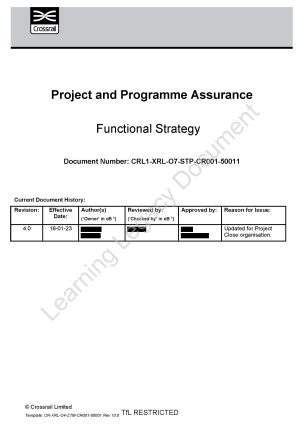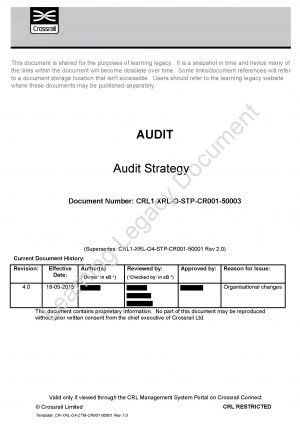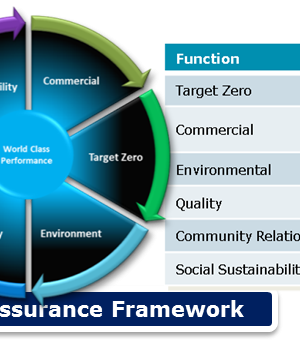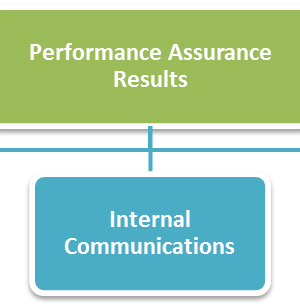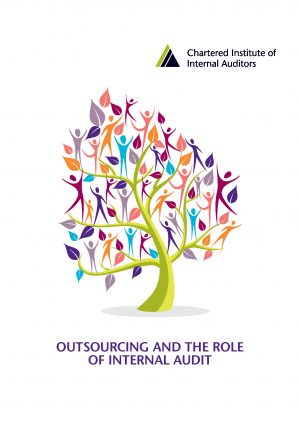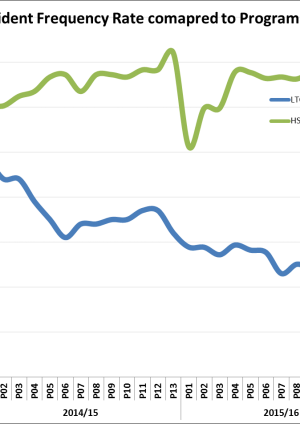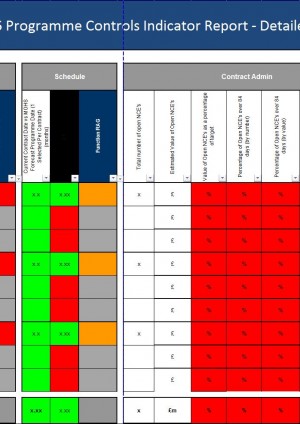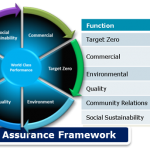 A key challenge for Crossrail and its stakeholders was to create a mechanism for assuring that Tier 1 contractors were collectively performing at a level that would enable the programme’s objectives to be met – safely delivering a world-class railway on time, within funding, setting new standards for major project delivery and leaving a legacy of improved supply-chain performance within the UK infrastructure sector. There was a desire to operate a lean client team and also a recognition that Crossrail had to enable the supply chain to perform if they were to be successful in achieving the programmes desired outcomes.
A key challenge for Crossrail and its stakeholders was to create a mechanism for assuring that Tier 1 contractors were collectively performing at a level that would enable the programme’s objectives to be met – safely delivering a world-class railway on time, within funding, setting new standards for major project delivery and leaving a legacy of improved supply-chain performance within the UK infrastructure sector. There was a desire to operate a lean client team and also a recognition that Crossrail had to enable the supply chain to perform if they were to be successful in achieving the programmes desired outcomes.
A Performance Assurance Framework was developed to measure performance, drive collaboration and share knowledge. The framework covers six key delivery functions:
- Commercial;
- Health & Safety;
- Quality (including technical compliance);
- Environment;
- Community Relations; and
- Social Sustainability.
The Performance Assurance Framework has supported a 54% increase in performance improvement. A learning legacy paper on the Performance Assurance Framework outlines the approach taken, including the use of ‘lead’ and ‘lag’ indicators to highlight performance improvement actions, as well as the results delivered to date and lessons learned in establishing the process. A future learning legacy paper will provide a reflective review of performance assurance, which will be at the completion of the programme.
Results from the Performance Assurance Framework are one of the inputs used to prioritise the annual audit plans. Other inputs include the risk registers, experience from previous audits and discussions with the Crossrail senior management team and project managers.
Crossrail’s approach to audit is set out in the Audit Strategy. The Audit Procedure sets out how Crossrail’s audit team implements Compliance audits and Contractor audits.
A public sector funded major project such as Crossrail needs to provide assurance to many bodies in relation to governance and the effectiveness of delivery. A Crossrail Integrated Assurance Group (CIAG) was set up to share assurance information with a view to reducing overall assurance intrusion from these different bodies, whilst delivering effective assurance. A review of the effectiveness of this group will be captured in a future learning legacy paper.
Crossrail has taken a proactive approach to fraud risk. A Fraud Risk Assurance Group (FRAG) was established to help raise awareness of the fraud risk across the Programme. It met for two years, and has been instigative in raising fraud awareness, not only within Crossrail, but also its Tier 1 contractors.
| Summary |
Publication date |
Document Type |
Topic area: Audit & Assurance in 2019 CRL implemented a ‘Three Lines of Defence’ Integrated Assurance Framework (3LoD IAF) to provide assurance to its Executive Group that it could safely deliver the Crossrail Project on time and to budget.
This was in response to the Sponsors (TfL and DfT) general requirement for programme assurance in the Pro...
|
18/05/2023 |
Good Practice Document |
Topic area: Audit & Assurance Research indicates that fraud and corruption remains commonplace in the UK construction industry. This report describes the measures put in place to help mitigate fraud risk on the Crossrail project. Benefits of communication and collaboration are highlighted as key areas of learning. This report would be of benefit to...
|
13/03/2018 |
Micro-report |
Topic area: Audit & Assurance The purpose of this audit strategy is to set out the principles of how audit is managed in Crossrail. This document covers all Crossrail audits: Crossrail Internal Audits; Crossrail Compliance Audits; Industry Partner Audits and Contractor Audits. It also covers all audit types; for example Quality; Environment; Heal...
|
14/03/2017 |
Good Practice Document |
Topic area: Audit & Assurance The Audit Procedure sets out how Crossrail’s audit team implements Compliance audits and Contractor audits.
Download the Audit Procedure here.
The procedure includes the following related documents:
Corrective Action Report (CAR) Form
Audit Report Template
Auditor Application Form...
|
26/02/2016 |
Good Practice Document |
Topic area: Audit & Assurance Crossrail’s approach to performance measurement was based on 6 core areas aligned to corporate objectives, using traditional quantitative based KPIs but supplemented with qualitative based assessments of the supply-chain’s maturity to provide a much richer picture of supply-chain performance. This enabled the tar...
|
26/02/2016 |
Micro-report |
Topic area: Audit & Assurance Performance data is generally kept within the project or programme landscape to aid decision making and understanding of project risk. Crossrail’s approach was to share data through a multitude of channels, both internally and externally ,leading to stimulation of competition and promoting innovation to support a c...
|
26/02/2016 |
Micro-report |
Topic area: Audit & Assurance The practice of outsourcing,or contracting out one or more elements of an organisation’s operations,has become widespread as large organisations seek to reduce costs,leverage technological expertise or improve customer value.
Whilst a third party relationship may improve efficiency and / or effectiveness, many of the...
|
30/09/2015 |
Journal Publication |
Topic area: Systems Integration and Technical Assurance An essential part of the Crossrail design review process involved the completion of both single disciplinary and inter-disciplinary design reviews. This provided an opportunity for interfacing Framework Design Consultants (FDCs), third parties, infrastructure maintainers as well as the Chief Engineer’s Group to scrut...
|
11/05/2023 |
Good Practice Document |
Topic area: Health and Safety improvements The Health and Safety Performance Index (HSPI) is Crossrail’s leading indicator measurement programme, focussed on Crossrail’s 6 Target Zero Pillars, which are considered the foundation for good health and safety management. These are; Leadership & Behaviour; Design for H&S; Communications; Workplace Heal...
|
27/09/2016 |
Case Study |
Topic area: Employment and Skills A joint Social Sustainability Working Group was first established in 2014. The participants were Crossrail staff and Tier 1 contractor representatives involved in the day-to-day management of Social Sustainability [1] issues at site level, including implementation of Crossrail requirements relating to:
Strategic Labou...
|
27/09/2016 |
Good Practice Document |
Topic area: Programme Controls A programme controls approach was needed to integrate commercial management information, to support decision making at the programme and sector level. Periodic Programme Controls Working Group meetings, combined with data and trend analysis, facilitated a good understanding of commercial performance across each of the ...
|
26/02/2016 |
Micro-report |
Topic area: Planning Planning of detailed design is often seen as abstract and difficult to measure progress against. This learning legacy paper describes how Crossrail, in conjunction with the design gates in the V-Lifecycle (Validation and Verification) technical assurance process, developed a detailed design programme in P6 and lear...
|
26/02/2016 |
Micro-report |
 A key challenge for Crossrail and its stakeholders was to create a mechanism for assuring that Tier 1 contractors were collectively performing at a level that would enable the programme’s objectives to be met – safely delivering a world-class railway on time, within funding, setting new standards for major project delivery and leaving a legacy of improved supply-chain performance within the UK infrastructure sector. There was a desire to operate a lean client team and also a recognition that Crossrail had to enable the supply chain to perform if they were to be successful in achieving the programmes desired outcomes.
A key challenge for Crossrail and its stakeholders was to create a mechanism for assuring that Tier 1 contractors were collectively performing at a level that would enable the programme’s objectives to be met – safely delivering a world-class railway on time, within funding, setting new standards for major project delivery and leaving a legacy of improved supply-chain performance within the UK infrastructure sector. There was a desire to operate a lean client team and also a recognition that Crossrail had to enable the supply chain to perform if they were to be successful in achieving the programmes desired outcomes.